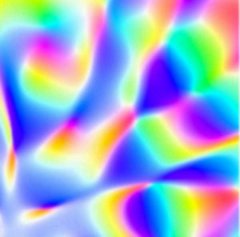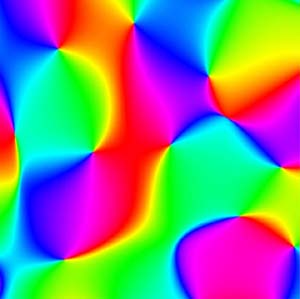Who could have failed to notice the shifting, shining patterns of light playing on the sand below shallow waters or at the bottom of a swimming pool? There is perhaps nothing more relaxing than watching the way the colours weave in and out of each other as waves ripple on the surface. Now, a British physicist believes he knows what causes such colourful displays and the answer lies in the shadowy world of dark light.
When two waves meet their peaks and troughs interfere. If the peaks are in phase one sees a higher net peak as the energies of each wave add together. If two troughs coincide, they subtract from each other making a deeper trough. On the other hand, when a peak and a trough meet they apparently cancel out. For waves on the sea, the effect is a patch of dead water. For light, the picture is altogether more complicated and beautiful as Michael Berry of Bristol University has discovered.

Michael Berry
Interference of white light produces coloured patterns, explains Berry, because the different wavelengths in the light add and subtract differently at different places. He has combined colour theory and wave physics to illuminate for the first time that calm water – the dark light. He has used a computer model to simulate the interference patterns produced by two light waves. Where peak and trough meet to cancel each other out he sees a region of dark light called a phase singularity.
In these special places the phase of the wave is undefined, just as time is undefined at the North Pole, says Berry. However, the colours hidden in the darkness can be predicted, he adds, By magnifying the intensity there, the colours form characteristic and striking patterns.

Dark light!
These theoretically predicted colours of dark light have yet to be investigated experimentally but Berry’s work predicts many different colour patterns in the dark light.

Random phases, which won first prize in the ’Visions of Science Photographic Awards 2002’ for the category of ’Science as Art’. Please see the website at: http://www.visions-of-science.co.uk/
For instance, random light waves, interfere to make delicate features, like the shimmering light at the bottom of a swimming pool, where the waves appear to move faster than light. One might say that Berry has unwoven the rainbow a little further than Sir Isaac Newton ever did with his prisms and shafts of light in a darkened room. Berry is showing that phase singularities lie at the heart of a most beautiful and relaxing natural phenomenon.
Berry published more details of his calculations in the New Journal of Physics.
Further reading
New J. Phys., 4, 74 (2002)
http://www.iop.org/EJ/S/UNREG/i2Q01uCcGWO1IGWmOlARJw/article/1367-2630/4/1/374/nj2174.html
Michael Berry
http://www.phy.bris.ac.uk/people/berry_mv/
Suggested searches
Interference light waves
Colour